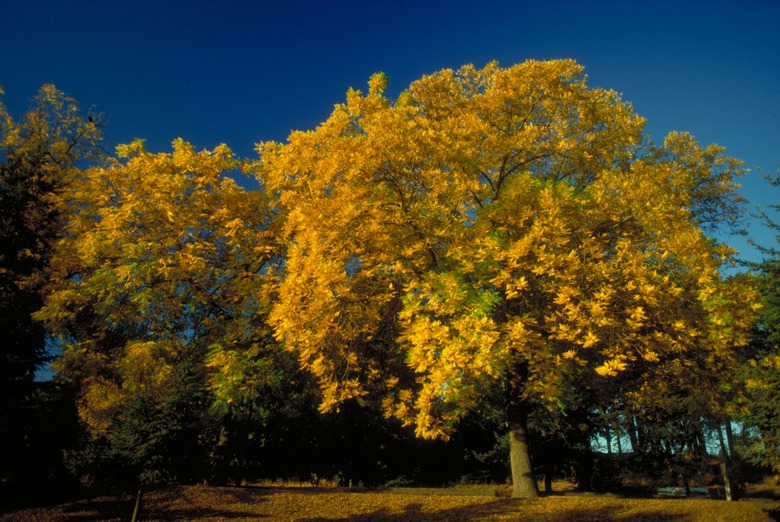How To Diagnose Curled, Brown Leaf Edges On Oak Trees
The oak tree (Quercus spp.), America's National Tree in 2004 and symbol of strength and courage, offers shade and gorgeous autumn leaves, acorns that delight young children and squirrels, majestic beauty and often just the right branch for a backyard swing. Oak trees thrive in full sun and well-drained soil in U.S. Department of Agriculture plant hardiness zones 3 through 9, depending on the species. Some species such as live oak (Quercus virginiana) grow 80 feet tall with canopies even wider. While oaks can live more than 200 years, they are not impervious to illness. Diseases and other factors can cause curled, brown leaf margins in oak trees. A little detective work will help you diagnose oak leaf problems and choose a treatment.
- The oak tree (Quercus spp.
- ), Some species such as live oak (Quercus virginiana) grow 80 feet tall with canopies even wider.
Timing Matters
Step 1
You may notice oak leaf symptoms during certain seasons or weather conditions. For example, anthracnose and oak leaf blister are generally non-fatal fungus diseases that cause curled leaf edges during wet spring weather. Oak wilt disease causes curled, bronze or tan leaf margins in late spring or early summer, and it can kill a tree in one season. If oak leaf edges turn a buff or creamy color after the first sub-freezing temperatures in the fall, frost may be the culprit. Choose oak species that are hardy in your region to minimize freeze damage.
Leaves Tell Their Stories
Step 1
The specific appearance of the affected oak leaves can help you diagnose oak leaf symptoms. Anthracnose causes random brown leaf blotches and curled leaf margins on lower, inner branches. Oak leaf blister can cause leaves to curl at the edges after yellow, raised spots on the leaves age and turn brown. Oak wilt symptoms begin with pale leaves and brown leaf veins and edges. Oak wilt begins in the upper branches and progresses to the lower branches.
- You may notice oak leaf symptoms during certain seasons or weather conditions.
- Oak wilt disease causes curled, bronze or tan leaf margins in late spring or early summer, and it can kill a tree in one season.
After the Leaves Fall
Step 1
An oak tree with brown, curled leaf edges may permanently lose its leaves or may grow healthy new leaves, depending on the cause. If your oak tree produces healthy new growth after it loses its damaged leaves, anthracnose may be the cause of symptoms. Leaves usually remain on an oak tree that has oak leaf blister. A tree infected with oak wilt disease may lose all of its leaves, or the leaves may stay on the tree after they curl and turn brown, according to the University of Illinois Extension.
Control and Treatment
Step 1
To control anthracnose, rake and remove leaves in the fall. To control severe anthracnose or oak leaf blister infections, mix 2 teaspoons of concentrated chlorothanolil fungicide in 4 gallons of water, and thoroughly spray the tree surface every 7 to 14 days in early spring. Limit pruning to the winter dormant season to prevent wounds that attract oak-wilt transmitting insects, recommends the Pennsylvania State University Extension. A certified arborist inject an oak trees with fungicide to control oak wilt disease, and if the tree doesn't survive, the professional can remove it. Warning: If you are pregnant or nursing, have someone else apply fungicides. Keep children and pets away from fungicides and treated trees. A tree care professional should apply fungicides to large trees with out-of-reach branches.
- An oak tree with brown, curled leaf edges may permanently lose its leaves or may grow healthy new leaves, depending on the cause.
- A certified arborist inject an oak trees with fungicide to control oak wilt disease, and if the tree doesn't survive, the professional can remove it.
Simpler Causes, Easier Solutions
Step 1
Other factors such as salt injury and excess nitrogen fertilizer can cause brown, curled leaf margins in oak trees. To avoid leaf damage from the salts in de-icers, do not use de-icers near your oak trees. To prevent brown leaf margins that occur from overfertilizing, limit fertilizer applications to 2/10 of a pound to 1 pound of nitrogen per 100 square feet each year for established trees, depending on the type of soil. Divide the nitrogen fertilizer into two applications in the fall and spring.
References
- Arboriculture and Urban Forestry: Oak Pathology — Using Oak Leaf Symptoms to Diagnose Recondite Maladies
- University of Minnesota Extension: Oak Anthracnose
- Cornell University Department of Plant Pathology: Oak Leaf Blister
- University of Illinois Extension: Oak Wilt Appears
- Pennsylvania State University Extension: Oak Wilt
